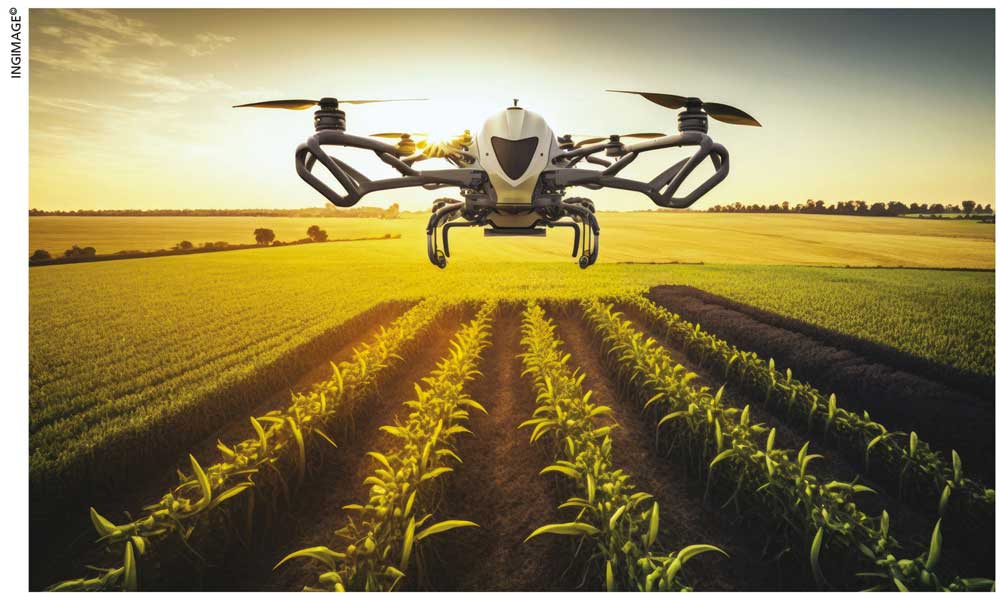ADOPT PRECISION FARM TECH
Akila Wijerathna explains how farmers can be more efficient and productive

Precision agriculture is an emerging trend that leverages state-of-the-art technologies and data analytics, to optimise crop production and resource management. It’s a comprehensive farming strategy that employs real-time data and cutting-edge technologies, to monitor and control various aspects of crop growth – such as irrigation, use of fertiliser and pest control.
By using precision agriculture, farmers can make informed decisions and implement precise interventions that improve crop yields, reduce waste and boost profitability.
It involves the use of various technologies such as sensors, drones, GPS, satellite, IoT, AI and machine learning, to collect, analyse and act on data about the condition of crops and farm operations.
These technologies enable farmers to measure and map the spatial and temporal variability of their fields, and adjust inputs and outputs accordingly.
For example, farmers can use sensors and drones to gather data on soil moisture, weather conditions and crop health, and variable rate technology (VRT) and precision planting to apply fertiliser, pesticides and seeds at precise rates and locations based on real-time data.
This will reduce the overuse or underuse of inputs, and enhance the efficiency and effectiveness of crop management.
Precision agriculture also benefits from the integration of artificial intelligence and machine learning, which can provide valuable insights and predictions for farmers. AI powered systems can analyse large amounts of data, and identify patterns and trends that will enable the optimisation of farming practices.
For instance, AI can predict crop diseases, optimise irrigation schedules and suggest appropriate fertilisation techniques, based on historical and current data. By leveraging artificial intelligence, farmers can make better decisions and utilise their resources more effectively.
Precision agriculture can help reduce costs and labour by streamlining farming operations through automation and data driven decision making.
Moreover, it can promote environmental sustainability by minimising the use of chemical inputs, reducing soil erosion and maximising resource utilisation, which contributes to sustainable agriculture and the preservation of natural resources.
One of the main challenges facing precision agriculture is the initial investment in technology, which can be prohibitive for small-scale farmers. Sensors, drones and software are both costly and complex; and they require technical expertise and training. Another issue is data privacy and security, which can be compromised by hackers or unauthorised users.
Furthermore, the compatibility and interoperability of different technologies and systems can be problematic as they may not work well together or with existing farming systems. This can result in a loss of data, errors or inefficiencies.
Another limitation is the scalability and adaptability of technology, to different farming conditions and contexts. The performance and suitability of precision agriculture technologies may vary, depending on the type, size and location of the farm, as well as crop, soil and climate characteristics.
Some technologies may not be applicable or effective in certain regions such as areas with poor connectivity, extreme weather or complex terrain.
Moreover, the adoption and acceptance of precision agriculture technologies may depend on social and cultural factors – such as the attitudes, preferences and beliefs of the farmers. Some may be reluctant or resistant to changing their traditional farming practices, or lack the awareness or knowledge of the benefits and opportunities of precision agriculture.
Possible solutions and recommendations include the provision of financial and technical support to farmers such as subsidies, loans, grants or incentives, to help them acquire and maintain precision agriculture technologies.
Another is to enhance data privacy and security by implementing encryption, authentication and authorisation mechanisms, as well as data protection laws and regulations, to safeguard information from unauthorised access or misuse.
The compatibility and interoperability of different technologies and systems can be improved by developing and adopting common standards, protocols and platforms that facilitate data exchange and integration.
Furthermore, the scalability and adaptability of technology can be enhanced, by designing and testing it for different farming scenarios and conditions, and customising and tailoring it to the specific needs and preferences of farmers.
Additionally, the adoption and acceptance of precision agriculture technologies can be increased by providing education and training programmes for farmers.
This will help raise their awareness and knowledge of the benefits and opportunities of precision agriculture, and equip them with the skills and competencies needed to use this technology effectively.





